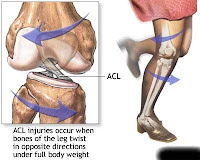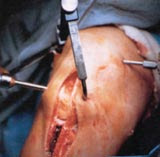Knee pain happens. Athletes and weekend warriors might find themselves with swollen, painful knees due to sports injury or simple overuse. Knee pain and swelling often needs to be checked by a sports chiropractor, but you can do some things at home that can help the healing process and prevent the painful knee from becoming a chronic injury.
Icing the knee at the painful injury site (see video) for 15 minutes at a time is crucial. Ice will decrease knee swelling and prevent the rapid formation of scar tissue. Ice saves–don’t forget this principle. Wrapping the pained knee in an ACE bandage will provide stability and prevent further knee injury. Then staying off the knee–NO SPORTS!–is essential.
Swelling can signify a torn knee ligament–like the ACL (anteriorcruciate ligament), PCL (posteriorcruciate ligament), MCL (medial cruciate ligament) or LCL (lateral cruciate ligament). Ligament tears can be rehabilitated conservatively, thereby avoiding knee surgery. A torn meniscus can also be conservatively treated. Meniscal tears can go through knee therapy and rehab successfully, but what is necessary is a proper knee diagnosis. If what you have is a simple knee sprain, then ice, therapy and rehab will get you back into your sport quickly.
If you have a painful knee injury get in to see a sports chiropractor right away. If you live or work in my neighborhood, come visit my Los Angeles, West Hollywood or Beverly Hills sports chiropractic office for knee pain relief today.

















